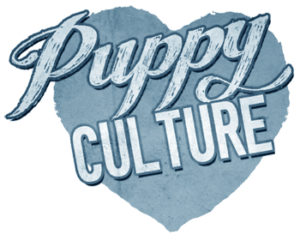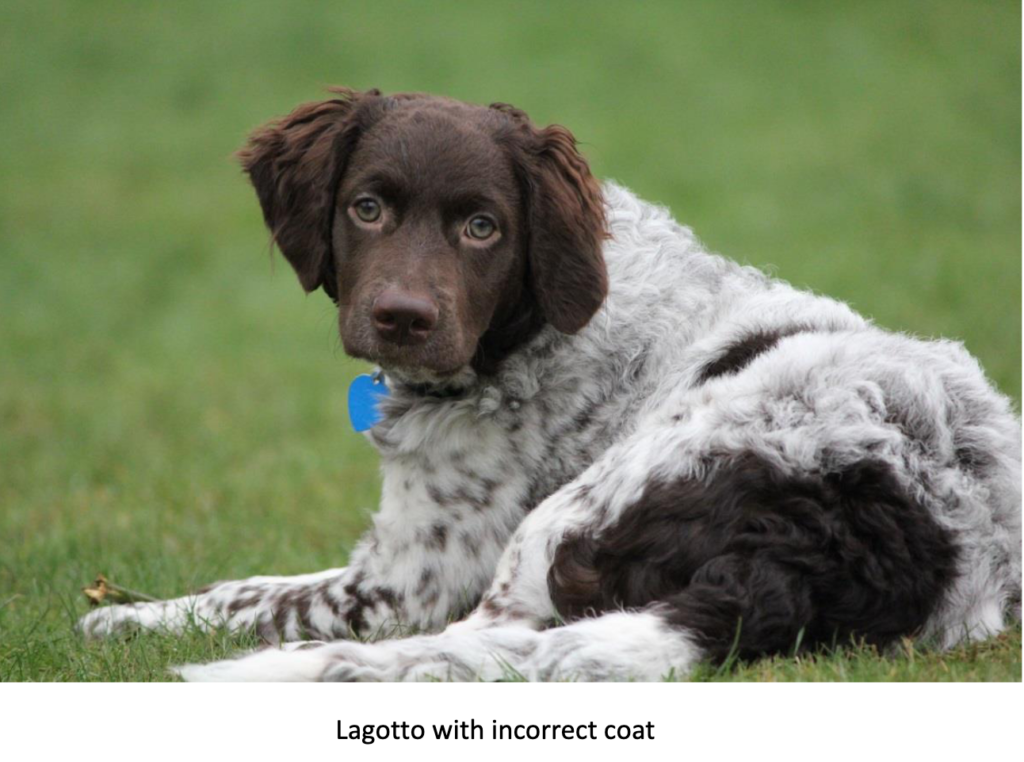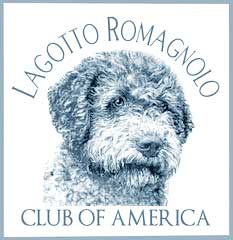Health – Lagotto Romagnolo
Benign Familial Juvenile Epilepsy was first recognized and reported in the Lagotto Romagnolo as early as 2002. The disease is described as inherited benign juvenile epilepsy. A similar disease is described in human medicine. It is an autosomal recessive gene that causes the disorder. The affected puppies usually show evidence of seizures and ataxia from 5 to 9 weeks of age and these resolve spontaneously by 8 to 13 weeks of age. Research at the University of Helsinki identified the causative gene in 2007, showing an autosomal recessive mode of inheritance.
Genetic testing for BFJE is available and it is recommended that all breeding stock be tested prior to breeding. Testing is available from Optigen in USA, Laboklin in Germany or Genoscoper in Finland.
Many countries have submitted samples and now, thousands of Lagotto have been tested for the BFJE gene. The data shows the following results of that testing: 3% affected; 46% carriers; 51% normal.To better explain what these results mean, please see below for definitions:
- NORMAL: The dog carries two copies of the normal gene and therefore has no predisposition to epilepsy.
- CARRIER: The dog carries one mutant and one normal copy of the epilepsy gene. The dog does not develop the disease but can transfer a gene defect to approximately 50% of its offspring.
- AFFECTED: The dog carries two mutant copies of the epilepsy gene and will likely develop the disease in early puppyhood. If bred from the dog will transfer the gene defect to its entire offspring.
Carrier dogs should only be mated to clear dogs so as to avoid producing BFJE affected puppies. It is NOT recommended to withdraw carrier dogs from breeding, as this would greatly reduce the already small Lagotto gene pool and not necessary when mating to a clear or normal dog.This concept and practice is consistent with the other Lagotto Romagnolo clubs and breeders worldwide, and follows the guidelines of genetics research and data.For more information, please visit the open access article on PLOS Genetics Website: http://journals.plos.org/plosgenetics/article?id=10.1371/journal.pgen.1002194
While considered very rare, another condition found in the Lagotto is cerebellar abiotrophy of CA. The main clinical symptoms in affected Lagottosare related to cerebellar dysfunction, and include difficulties in controlling movements and balance. Some affected dogs have also suffered from abnormal eye movements (nystagmus) and behavioral changes, such as aggression and restlessness. The owner-reported age of onset has varied from 4 months to 4 years.
This condition being researched at the University of Helsinki and the University of Bern and is form epilepsy in the breed that is unconnected with the BFJE mutation. The age of onset is adulthood. The number of confirmed cases is low and research is continuing. There is currently no commercial test for this disease and more research is needed.
More information on the condition and research can be found on the University of Helsinki genetic research site: http://www.koirangeenit.fi/english/projects/ongoing-research-projects/neurological-diseases/ataxia/
Very few cases of juvenile cataracts have been found in the Lagotto. In both Germany and Switzerland, several samples have been taken and are being studied in order to examine the possibility of inherited cataracts, and those results are still pending. LRCA member breeders are required to have any breeding dogs eyes tested and cleared by a board certified ophthalmologist before any breeding. Results are to be submitted for certification either through the Orthopedic Foundation for Animals, or equivalent in a foreign breeder’s country of origin. Breeders are required to have this test done on an annual basis on any breeding dog. One condition that has been reported in some Lagotto is called distichiasis. While it has been found in some lines, it has not been found to be a major issue in the Lagotto. Per the American College of Veterinary Ophthalmologists website:
Distichiasis is a condition where eyelashes emerge from the ducts of glands within the eyelid (Meibomian gland) which does not normally produce hairs. These “extra” eyelashes often rub on the surface of the eye and may cause irritation.
For more explanation of treatment, please refer to the ACVO website on this condition: http://www.acvo.org/new/public/common_diseases/distichiasis.shtml
Storage disease is a severe and lethal neurodegenerative disease found in the Lagotto, and is auto-recessive. It is essential that no affected dogs are bred and carriers must only be bred to a clear.The disorder was recently identified in the Lagotto by researchers at the University of Helsinki and the University of Bern.Here is a portion of a letter posted on the University of Helsinki site (http://www.koirangeenit.fi/?x103997=272870):
Dear Lagotto Romagnolo owners,
We have recently identified a gene mutation that causes a neurodegenerative storage disorder in the Lagotto Romagnolo breed. The clinical and genetics studies were performed as a collaboration between researchers and veterinarians at University of Helsinki, Finland and University of Bern, Switzerland. Altogether 1300 Lagotto samples were tested during the study, and 11 % of these were carriers of the storage disease mutation. These results have already been sent to the owners.
Onset of symptoms can appear from 4 months of age to 4 years. This is a progressive disorder. Those dogs affected will deteriorate to the point they will need to be euthanized. While genetic testing is currently only available through the University of Bern, a commercial test is now available through Genoscoper Labs. A responsible breeder always tests for genetic mutations before any planned breeding.
While rare, a Lagotto can be born with an incorrect or “short-coat.” This is an appearance issue and not a health one. These dogs are perfectly healthy and all Lagotto, but if two “carrier” dogs are mated, it is possible for some of the off-spring can be born with a short, flat coat, and not develop the normal curls associated with the Lagotto. The puppy’s parents will most likely have normal coats. This incidence does not become apparent until the dog is 4-6 weeks of age and the hair on the legs, head,muzzle and body will be short and fine, and they do tend to shed. This genetic mutation is the same one found years ago in the Portuguese Water Dog. An “improper-coat furnishings” test became available in 2011, and is available from Optigen in the US and Laboklin in Germany. It is recommended that breeders make sure that at least one dog in the breeding pair be tested “normal” for incorrect coat.
Hip dysplasia is a malformation in the hip joint and is a multi-genetic inherited trait. Dogs affected by this condition will lead to eventual deterioration of the hip. Arthritis develops and reduces function and mobility for the dog, and can be very painful. It is one of the most common health occurrences in dogs, with the large and giant breeds being thought to be the most affected. However, smaller breeds are not immune when affected, and tend to show less obvious signs. Hip dysplasia can be found in the Lagotto and therefore, responsible breeders make sure that they get hip radiographs (x-rays) on any dog in their breeding program and only breed dogs with passing scores. Two different methods are used/acceptable: OFA (OrthopedicFoundation for Animals) and PennHip. More information can be found on their websites:
- http://www.offa.org/
- http://info.antechimagingservices.com/pennhip/
The luxating kneeis one that “pops out of place” and can follow genetic lines. According to the data on the Orthopedic Foundation for Animals website and the limited number of dogs tested, about 3% have patellar luxation. It is generally most common in toy, miniature, large and giant breeds. In the Lagotto, it may or may not be a heredity issue, but one that most Lagotto breed clubs throughout the world are monitoring and encouraging testing for. For more information on patellar luxation, please see the link to the Orthopedic Foundation for Animals website: http://www.offa.org/pl_overview.html
Another type of degenerative joint disease is elbow dysplasia. It is an inherited polygenic disease in the formation of the elbow. While some breeders may choose to have elbow x-rays done at the same time as hips, there have not been significant numbers of elbow dysplasia found in the breed and is therefore not a required test for LRCA member breeders. According to the OFA database, dated December 2014, 100% of the Lagotto Romagnolo’s tested have been normal. However, only 67 dogs have been entered into the public database. Foreign countries are also beginning to track elbow results along with hips and patella and more data should be available as more dogs are entered into these databases.
Puppy Culture Program

High-quality
Our puppies are raised in the home, are fed a high-quality diet and we follow the Puppy Culture Program for proper socialization and training.

 Download / Printable PDF’s
Download / Printable PDF’s